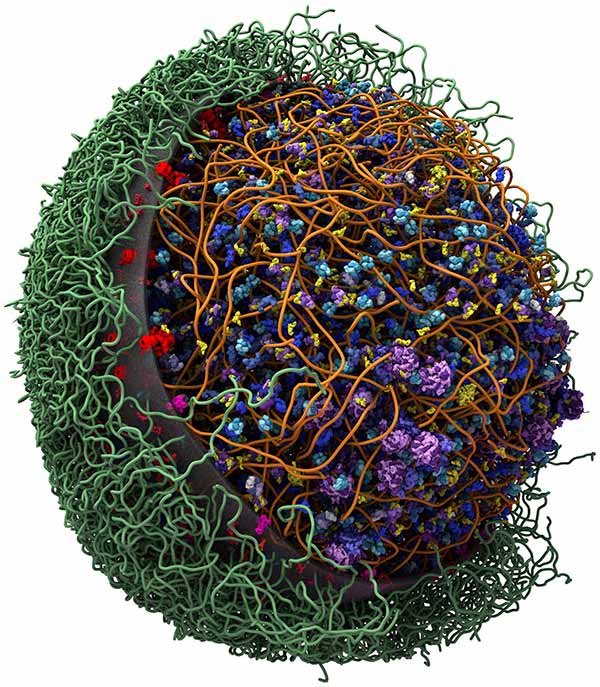UC San Diego and TSRI Launch New Consortium to Create ‘Virtual Cell’
Published Date
By:
- Mika Ono and TSRI
Share This:
Article Content

Credit: Art Olson and TSRI
Drawing on complementary strengths, the University of California, San Diego and The Scripps Research Institute have formed a new consortium with a big mission: to map cells in space and time.
The consortium will offer fellowship funding for 10 to 12 graduate students and postdoctoral fellows to work on collaborative projects that build bridges between the campuses and different disciplines to assemble and simulate a virtual model of a cell, down to an atomic level of detail.
“Leveraging existing strengths at UC San Diego and Scripps, the collaboration will advance scientific excellence and research infrastructure at both institutions,” said UC San Diego Chancellor Pradeep K. Khosla. “The goal of building virtual cells poses an important challenge to researchers in fields from experimental biology to computation and information analysis.”
“We are entering into this promising collaboration between our campuses with great optimism,” said TSRI Acting President and CEO Jim Paulson. “The Visible Molecular Cell Consortium aims to bring together the best minds from different disciplines to understand and articulate how the body’s cells work, which will lay important groundwork to understanding health and disease.”
The Visible Molecular Cell Consortium will be directed jointly by Art Olson, professor at TSRI and Rommie Amaro, associate professor of chemistry and biochemistry at UC San Diego.
“This is a particularly exciting time for such efforts, due to a number of technological and scientific factors,” said Amaro. “Advances in various imaging technologies, modeling frameworks and cyber-infrastructure are enabling us to make new strides in the creation of 3D virtual cells. This timely new inter-institutional alliance will provide new insights into the inner workings of cell machinery, some of which may present opportunities for novel therapeutics.”
In recent years, more powerful imaging devices and automated programs in high resolution imaging have provided more detailed pictures of cells and their proteins than ever before, but scientists have not yet translated the huge amounts of data into a single, atomic-level cellular model. This is a “big data” challenge, Olson points out, applied to the uncharted territory of cellular architecture and ecology.
“Even the simplest living cells contain 1 to 2 million proteins, of 3,000 to 4,000 different types,” said Olson. “Figuring out how they work together over time will shed light on the cell as a living, working individual entity. Just like you couldn't build a car from just its wiring diagram, we can't have a complete understanding of a cell unless we know how all of its physical parts work together in 3D.”
The researchers hope to one day be able to zoom into cells at the atomic level and zoom out to see “nano neighborhoods,” where cells interact. On top of that, they aim to visualize protein interactions in real time to better understand cellular function. The new consortium will help scientists put the pieces together.
TSRI is known for its structural biology using both cryo-electron microscopy and X-ray crystallography, and both Olson's and Amaro’s labs develop and use advanced graphics programs to visualize complex cellular machinery. UC San Diego is home to the only publicly available supercomputer in California and the National Biomedical Computation Resource, a National Institutes of Health-sponsored national resource that develops multi-scale modeling tools.
Olson and Amaro plan to host their first “lightning talk” workshop, where any scientist can present their work and seek out collaborators, on Oct. 2. They also plan to organize a bi-annual conference to encourage new collaborations and share results. Researchers interested in learning more about the consortium are encouraged to contact visiblemolecularcell@gmail.com.
The organizers anticipate the consortium will be particularly strong in neurological diseases and infectious diseases, such as influenza, HIV and Ebola virus, although the insights into cellular behavior will be applicable across many fields.
Share This:
You May Also Like
Stay in the Know
Keep up with all the latest from UC San Diego. Subscribe to the newsletter today.



